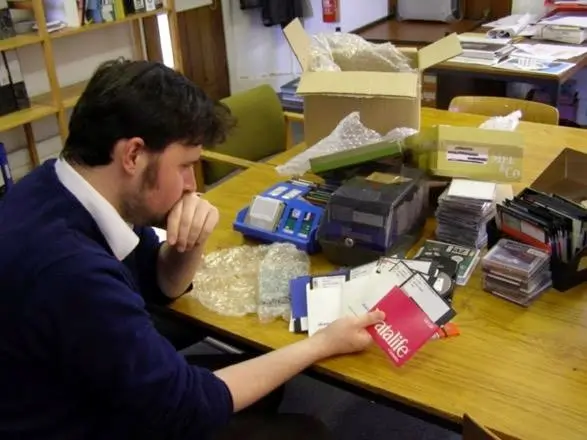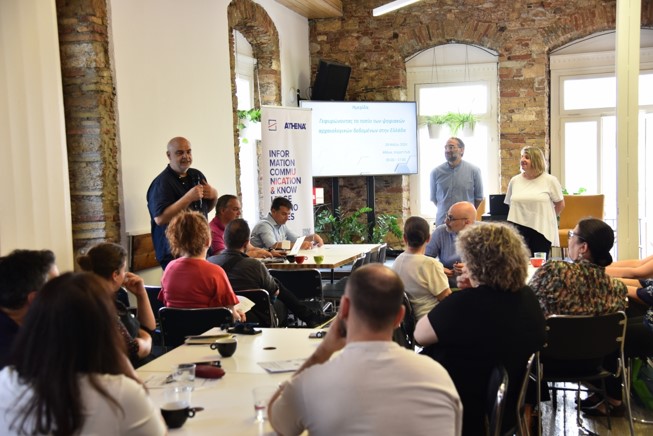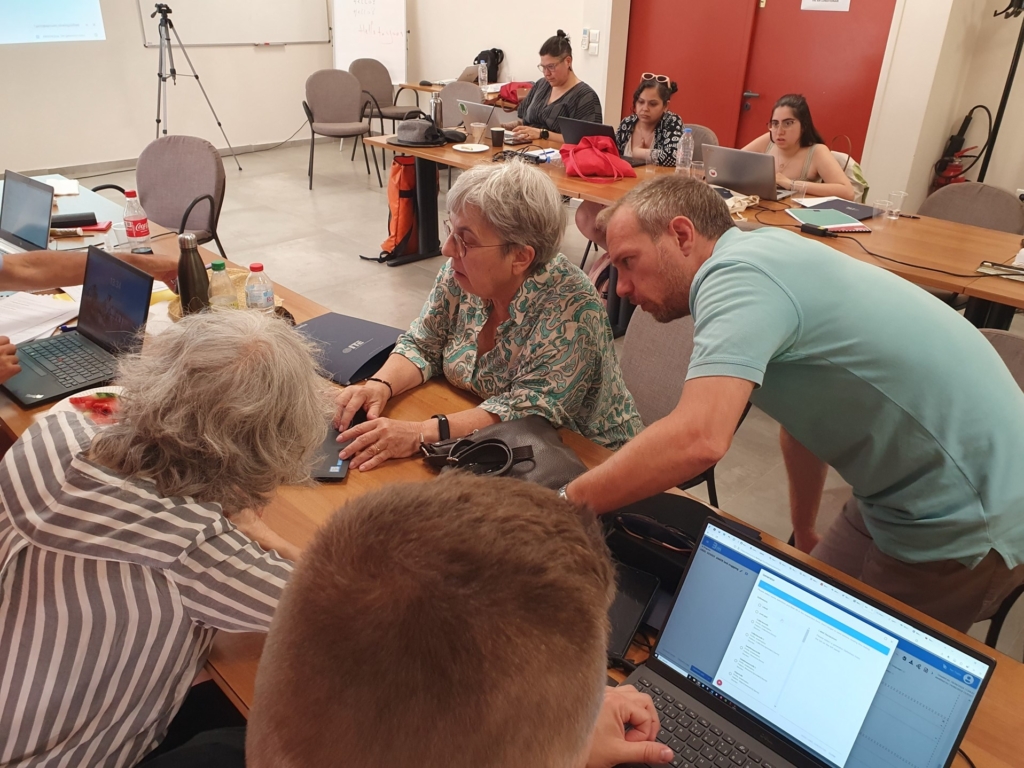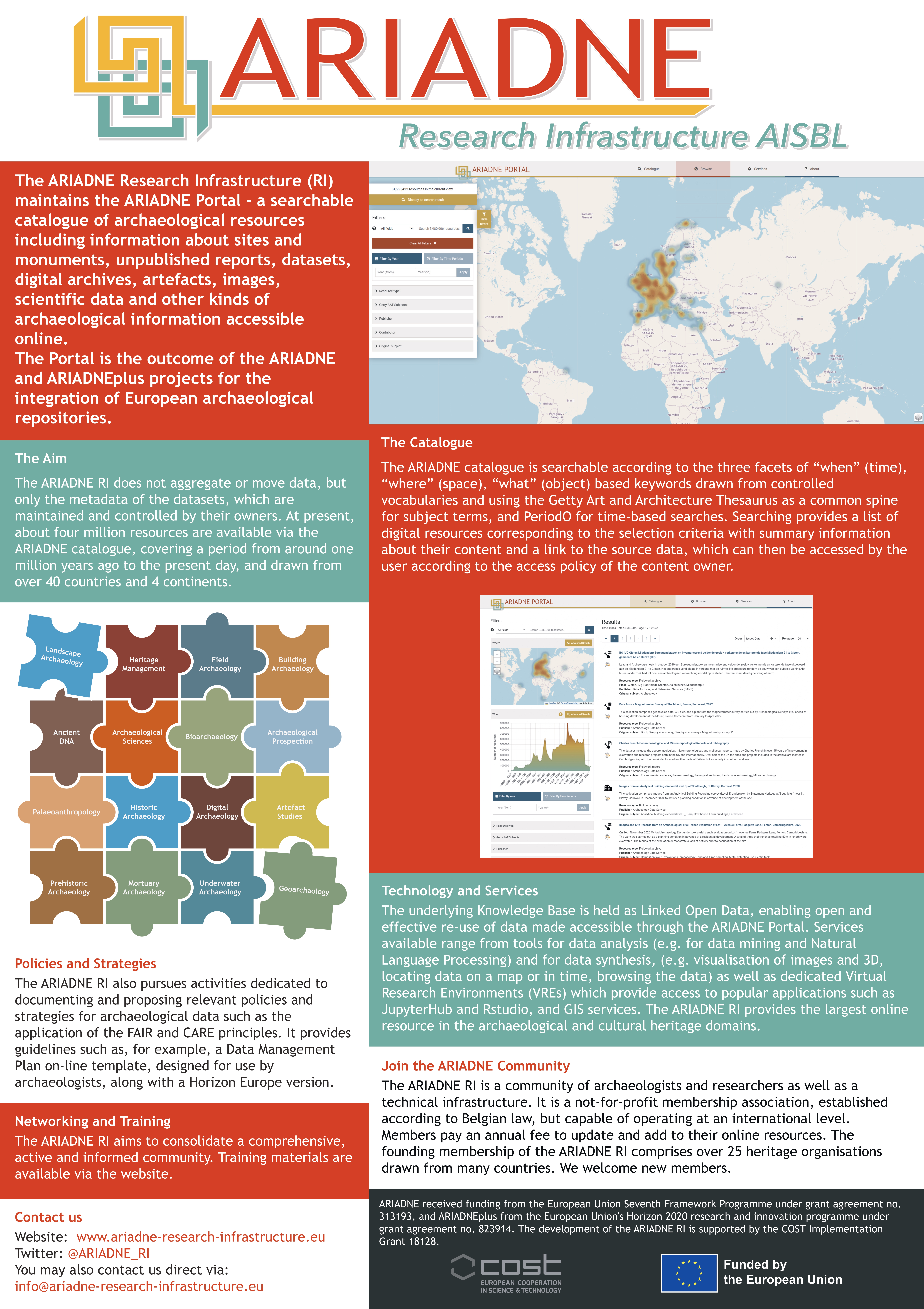Modern archaeology is increasingly reliant on digital technology, and while computing has brought liberation to the field in many ways, critical challenges are emerging when it comes to the digital resources produced. The archaeological record, in digital form, is at risk not simply from obsolescence and media failure, but due to variations in practices the domain is unable to fully participate in Open Data. Without swift and informed consensus, archaeology will lose the majority of its research data legacy to a digital Dark Age.
Interestingly, archaeology faces several challenges from a data perspective that are distinct from other domains. Archeologists are creative and innovative in their methodologies; adopting, adapting, and developing novel techniques and approaches, but this requires stewardship of a far greater variety of data formats than other cultural and scientific domains. Many forms of archaeological research (including excavation) destroy the cultural resource, and the recorded observations become the primary record, derived from non-repeatable documentation. Finally, archaeological data is often born digital, and there are no paper surrogates for the primary record so obsolescence and media failure are a real risk when technology advances so quickly.

The COST Action Saving European Archaeology from the Digital Dark Age (SEADDA) was established five years ago to mitigate the loss of primary archaeological data by developing common understandings around data stewardship, building new best-practice networks to support the preservation and open dissemination of archaeological data, and the creation of more inclusive research partnerships.
To learn more about the impact and successes of this network we hear from two of it’s key players: Dr Holly Wright from the Archaeology Data Service in the UK, Science Communication and Grant Awarding Coordinator for SEADDA, and Prof. Julian Richards from the University of York, Chair of SEADDA.
Interdisciplinarity
So what do you do when your research field is facing a digital Dark Age? “In SEADDA we worked to mitigate this crisis by bringing archaeologists and data management specialists together to share expertise and create appropriate sustainable resources.” explains Prof. Julian Richards, Chair of SEADDA.

Only by bringing together a wide variety of stakeholders and decision-makers, from both the technology and archaeology domains, can these challenges be successfully addressed. For SEADDA this included representatives from countries, regions and institutions with all levels of experience and expertise.
“An interdisciplinary approach was needed to fill a gap between the archaeologists and information scientists. We needed to jointly develop digital preservation methods that align with the FAIR principles of Findability, Accessibility, Interoperability and Re-usability and share best practice across Europe.”
Prof. Julian Richards, Chair of SEADDA
Pandemics and papers
Having kicked-off in March 2019, SEADDA was just starting to ramp up its networking efforts when they were forced to adapt an in-person network to a virtual environment due to the onset of COVID-19. They adapted well switching to virtual workshops, online STSM visits, and embracing the new Virtual Mobility Grant launched by COST to fund great projects like research on creating a FAIR pottery database. SEADDA even shared its lessons learned from the period in the paper ‘Challenges and opportunities in virtual archaeological data stewardship: Moving SEADDA COST Action online‘ presented at the International Conference on Cultural Heritage and New Technologies (CHNT) in Vienna in 2021.

The challenges brought about by the pandemic created other opportunities for the network, such as focusing on Open Access publications. 45 peer-reviewed, Open Access publications, representing both key syntheses and the individual state-of-the-art in over 30 countries, nations, and regions are a major output of the network. These publications, developed by SEADDA members, set out long-term data stewardship and management as an important research area for the foreseeable future, based on common understandings. SEADDA are in the process of publishing the full ‘SEADDA Collection’ encompassing all academic output of the network in one place, meanwhile many of the papers are available here and here.
Increasing international awareness
To develop a common understandings around data stewardship in archaeology SEADDA had to ensure it had a wide and diverse reach. The network’s success was, in part, based on its ability to mobilise a diverse group of network members and external stakeholders, from all career stages and geographic locations.
“SEADDA greatly increased international awareness across the domain about the loss of primary archaeological data; that the archaeological record, in digital form, is at risk not simply from obsolescence and media failure, and is largely comprised of non-repeatable research. SEADDA raised awareness and made this issue a topic of conversation at every scale; from the most influential academic conferences to the individual archaeologist working for a national heritage agency in a single country.”
Dr Holly Wright, Grant Awarding Coordinator for SEADDA



SEADDA worked to ensure equity between COST Member Countries. Even countries where there has traditionally been no discussion of this issue were able to use the support, expertise, and leverage associated with participation in SEADDA to create local change. In particular, the SEADDA National Workshops in Turkey, Serbia, Ireland, Norway, Romania, France, Greece and Portugal) confirmed SEADDA has developed a model that works and can be implemented in the future; empowering local members, many of whom were Young Researches and/or based in Inclusiveness Target Countries (ITCs), to take on leadership roles within the network and give ownership of the solutions to their local research communities.


While the focus of SEADDA was Europe, the network achieved active participation from a range of other countries such as the USA, Japan, Argentina, Israel, and Turkey. “Every country has an archaeological record and faces the same challenges, but sustainable solutions are only possible when driven by the people within those countries. This can often be very isolating for those who see and understand the problem, and working with decision-makers to facilitate change can be daunting” explains Holly. “Being part of the community developed by SEADDA means we are able both support each other as we seek to create change locally, and it allows us to speak together with one voice with years of collaborative development and best practices behind us. Working with researchers outside of Europe and across the world is crucial, because the more we amplify each other’s voices, the more quickly we can act to mitigate archaeological data loss.”
Building a Research Infrastructure
Many SEADDA network members had long been collaborating with the EU funded projects ARIADNE (FP7), ARIADNEplus (Horizon 2020), and the follow-up ARIADNE Research Infrastructure (RI). The synergy between the ADRIANE projects and SEADDA COST Action was perfectly aligned and helped widen the support available for the archaeology community in furthering its research data harmonisation.

The ARIADNE RI was established as a not-for-profit association and to provide individuals and organisations with skills and tools to publish their data online, without duplicating efforts at national, regional, and local levels. The goal was to create a single point of access, capable of addressing major research questions and solving heritage management problems, but ARIADNE RI needed a straightforward financial model to maintain and develop the portal.
The SEADDA network applied for, and was subsequently awarded, a COST Innovators Grant (CIG) for Sharing Heritage and Archaeological Data Effectively (SHADE), a 12-month follow on grant to develop the ARIADNE RI business plan and ensure a sustainable outlet for ongoing progress and collaboration.
SHADE needed to create a charging model for the ARIADNE RI, based on the actual costs of adding data sets to the Knowledge Base. The business plan needed to ensure that the costs of updating existing data, adding new data sets, and adding new members were covered.
“The creation of our CIG business plan has helped us see how and where we need to expand and enhance our collaboration, and the importance of taking an iterative approach. We have plans, but we also try to be as flexible as possible, as we never know when or how a new partner will emerge, but we know we have an open, supportive, and knowledgeable community of practice for them to join, and help to shape.”
Dr Holly Wright, Grant Awarding Coordinator for SEADDA


SHADE has been working to promote ARIADNE RI internationally in order to attract new datasets and members while also providing training in the preparation of FAIR archaeological data for aggregation in ARIADNE RI.


This included the development of different communications materials for ARIADNE RI like animations and promotional posters:

So what about the future? With a firm business plan in place, ARIADNE RI now has a small but stable revenue stream from the Association members and follow-on EU funding that helps assure its financial position for the foreseeable future. The follow-on projects are ATRIUM, a collaboration with other leading Arts and Humanities RIs (CLARIN, DARIAH and OPERAS) which will enable additional data types (text, audio, video and 3D) to be integrated into the portal, and ECHOES, advancements that will enable ARIADNE to integrate with the EOSC and to represent the archaeological community in the building of the European Collaborative Cloud for Cultural Heritage. Another possible future income stream is from franchising the existing Portal technology for localised versions, to be assessed on a case-by-case basis. Finally, members of the originally SEADDA network will also be involved in the new COST Action Managing Artificial Intelligence in Archaeology (MAIA) kicking off in September 2024 where Holly adopts the position of Vice-Chair.
The scale of ARIADNE RI has now expanded to over 4 million digital resources covering some 50 countries, 4 continents, and the whole span of human history from early hominids to the Cold War. The detailed mapping of the market size of archaeological data, as carried out during their business plan exercise, has established the goal of adding one million new records to the ARIADNE Catalogue annually.
“ARIADNE RI is now meeting a growing demand for better archeological data management through the application of the FAIR Data Principles and providing greater visibility to data held by different institutions and organisations. We built a strong and inclusive network and have a sustainable outlet for ongoing progress. We are committed to protecting European archaeology from a digital dark age.”
Dr Holly Wright, Grant Awarding Coordinator for SEADDA
